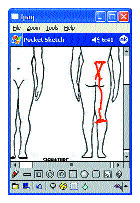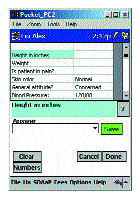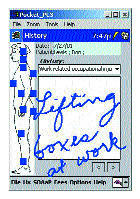

Mobile Computing:
Charting With PDA TechnologyThis section is compiled by Frank M. Painter, D.C.
Send all comments or additions to: Frankp@chiro.org




Thanks to Today's Chiropractic for permission to reproduce this article!
By C.M. Wilkerson, D.C.

In the early 1980s, I sat in front of my office computer, a 286 Hewlett Packard Vectra desktop model with a 10-gigabyte hard drive. The salesman assured us we would never need anything bigger or better. The salesman told me many other things, but I had no idea what he was talking about. I felt like I had been parachute-dropped into a foreign country, where the citizens spoke pure techno-babble.
It was then that I decided that I had to be technically informed about computers or else I would be at the total mercy of salespeople. I didn’t like this feeling.
At any rate, I was fascinated by this Vectra box with a brain, which seemed to reach out and accomplish tasks. Now, if only I could place this PC in all my adjusting rooms so I wouldn’t have to keep running out to the front desk. Since then, my goal has been to put a computer in my pocket.
Today, I can’t say enough nice things about a Palm handheld computer. I started with a Palm and still use a Palm. I totally believe in the Palm philosophy of simple is better. Einstein (1879-1955) said it best: “Make things as simple as possible and no simpler.”
In 2002, however, I want more than what a Palm OS can accomplish. I want a computer in my pocket. The Palm, for all its benefits as a reference tool, does not have the power of a computer. Having reference material is a good and necessary objective, but crunching data and viewing the result right on the handheld device, in a multi-tasking environment, is the front-end foundation of an Electronic Medical Records (EMR) system.
A System For Documentation
I would like to share how I use a personal digital assistant (PDA), throughout my day, to chart patient encounters. As a chiropractor, I provide care for musculoskeletal problems of somatic origin.
Design: My office has a simple peer-to-peer Windows 2000 server that contains my practice management program, Medical Business Automation (www.mbanet.com). I use www.eclaims.com for electronic billing. I use MS Office XP Professional with MS Outlook for communicating with my office staff. I also use a wireless Access Point on my server that allows me to roam my 2,500-square-foot office while sharing a broadband DSL connection on my Fujitsu notebook.
Material: I have a mixture of Linksys and D-Links hubs and routers including a Lucent RG-1000 wireless Access Point, networked to six desktop workstations running an eclectic collection of 2000 Professional, Windows 98 and one Linux box. I have nine adjusting rooms, and I use a wireless Fuji pen notebook, when needed (www.digital-doc.com/wireless.htm).
My PDA of choice is an Ipaq 3850 with 64 MB of RAM and another 128 MB in my SD memory card. I use a Palm m505 as a backup for reference material and use programs such as Contacts and ePocrates.
Preparation: The first thing I do every morning, before a patient encounter, is exercise. Without my custom exercise routine, there is no way I could be at my mental or physical best. My usual routine consists of exercising my right flexor digitorum profundus by pushing the sync button on my Palm m505. My Palm desktop settings are set to update ePocrates (www.epocrates.com) and other reference material and synchronize my Desktop Outlook 2002 with the desktop overwriting the handheld.
Then, I head for my 6-ounce forearm/wrist routine (prophylactic for carpal tunnel) by dropping my Ipaq into its USB cradle. Seamless synchrony takes place automatically with my settings enabled to synchronize all the files. This dual synchrony setup (Palm and Ipaq Pocket PC) ensures that my Palm and Pocket PC are symbiotic and non-parasitic. I love the prudent simplicity of the Palm OS and the power of the Pocket PC. Both of my handheld units contain the same basic programs, in most cases.
While there remains a plethora of Palm applications, my Ipaq provides my personal panoply. The Pocket PC has all the health-care applications I need and can do so much more. The Pocket PC OS has a steeper learning curve than the Palm OS, but so did Windows compared to DOS.
Recording Patient Information
My workday begins by downloading my patients’ files for the day into my Ipaq. I use a custom SOAP program, designed for musculoskeletal trauma, called Digital-Doc (www.digital-doc.com).
I use a custom Visual Basic utility on my desktop (part of Digital-Doc) that reaches across my network and imports my calendar database (an Access .mdb) file from my practice management system (PMS). The program imports the data into an Active Sync subdirectory on my Ipaq. This subdirectory is automatically synchronized with my Ipaq anytime it is placed in the cradle. With the Ipaq in the cradle, I then open the Options menu on my Digital-Doc software and tap on “Import the Calendar.” The entire process of importing 50 patient files and loading them into the Digital-Doc software takes less than 10 seconds.
Then, I remove the Ipaq and head for my first patient encounter. If the patient has not seen the Ipaq, I show it to them. I then ask the patient to physically “touch where it hurts.” Asking the patient to touch on their body where it hurts helps prevent miscommunication. Looking at an image of a body, I simply tap on the area of chief complaint, the box lights up red, and all dropdown menus are loaded to match that specific area. All choices for patient complaints, exams and diagnosis are only pertinent to that same area of the body. The body part chosen is specifically correlated with the appropriate corresponding customizable choice. There are no superfluous, irrelevant choices!
I then choose the chief complaint and continue the encounter, asking the patient about severity, frequency and other aspects. I can cycle through each SOAP screen in this manner, tapping and picking and choosing. Alternatively, an even quicker and preferred method is to choose a template based on the anatomical area that the patient has indicated is the area of their chief complaint. I simply click on “Options,” load a template, and save it. 1-2-3 and I am done! I change only what is different.
At this point, I can read or print the entire note in Pocket Word or save it and move on to the next patient. The objective portion of the software also includes a comprehensive customized exam grid (the user can customize it for their specialty) that can be used for an extensive examination. In my case, as a chiropractor, the grid is set up for vitals, inspection and palpation, ROM, orthopedic and neurological exam, medication, X-ray, etc. This grid can be altered for virtually any health specialty.
Entering a patient history on the fly is quite easy with the combination of pop-up choices and a transcriber, which saves time and makes it easier to enter data without typing!
One of the features of this software is a recommended care plan reminder. For example, I can program it for six visits. When the patient reaches his sixth visit, the program reminds me. I use this to remind me that a report is due for third-party re-imbursement, or that the patient should be re-evaluated. If instructed, the software will remind me of a patient’s birthday as well. In addition, I can schedule the patient from the Ipaq with a field that pulls up a virtual appointment book. This can be helpful when checking your schedule on the road. On occasion, I will dictate a verbal note, which is also saved in my chart directories on the Pocket PC for easy retrieval and synchronization. I can listen to this .wav file on my Ipaq or my desktop computer.
My Ipaq has 64 MB of memory, which allows me to record all my patient encounters without having to upload the data to my PC in order to make more room. My old Palm software mandated daily uploads and only the last visit was stored on the device. I record all my patient visits on my Ipaq, and I only need to archive them when they are no longer under active care.
I can search all my patient files with a search feature in the Digital-Doc software. It is extremely important to have all the patient data at my disposal. For example, if I am looking for a particular test, like an MRI, I can search all my charts in a second, without having to pull a paper file that is archived in the next room. The information is in front of me in seconds. Additionally, while out of the office, I can use this search feature to follow up on a patient by searching for a specific key word or phrase that I might put in the comments section of my software.
I use a Pocket Anatomy program to show patients images of the area of their complaint. Showing the patient the muscle or anatomical area that is injured is a great help in assisting their understanding of their pain. With biomechanical injuries, part of getting well is understanding what is wrong and how to prevent recurrence. A simple color picture says so much. I also cut and paste my own pictures for this purpose that I store in a separate subdirectory.
The 5-Minute Clinical Consult program is a constant resource, as well as LexiDrugs. These days, it seems that most people are on one prescription or another, and it is imperative to know how the medication affects their physiology and symptoms. Chiropractic care and contraindication to care can often be contingent on a careful history that records what medications the patient is taking.
HIPAA-oriented password protection is also included the Digital-Doc software that I use. I set my time for 10 minutes. The device automatically shuts down in the “absence of user-determined use.” This feature would prohibit unwanted users from seeing patient information.
Integrating Office Data
The Digital-Doc has the ability to capture fees due for services when the patient encounter notes are made. This information can be saved for transfer to the person posting charges, or to my PMS for electronic billing to www.eclaims.com.
At the end of the day, week or month—or literally, whenever I decide—I can “build my charts” by date range, for all patients or individual patients. I can keep them on my Ipaq, which then synchronizes with my desktop as soon as I drop it into the cradle.
I can print my charts on my Infrared HP 2100 LaserJet or, alternatively, I can go to my desktop PC and open the charts for printing or editing.
My Digital-Doc software application automatically synchronizes with my desktop Access .mdb file via Active Sync. From my desktop, I can run Access reports and queries, sort data and merge with MS Word. I can make changes on the desktop Access file and then restore to my Pocket PC if desired. It works bidirectionally.
Backup: Presently, I have a dual backup option. I can do it manually via coded software or automatically with Active Sync. Automatically, my table and data are backed up with Active Sync as soon as my Ipaq is placed in the cradle. However, I can also backup my data right from my Pocket PC, via the Options menu of my Digital-Doc software. This may sound confusing and perhaps redundant, but it enables me to have a dual backup system in place.
Summary
Here is the bottom line for my practice: Mobile computing means less stress and better patient documentation. This translates to better patient care and better financial reimbursement. Any SOAP notes, exams or reports (workmen’s compensation, personal injury, HMO and insurance) can be generated from any computer in the office based on what has been done (data input).
I firmly believe that a handheld device is the best, most convenient front-end adjunct to EMR. However, the front end is only as good as the back end. Application performance on the Pocket PC is much closer to desktop performance than demonstrated by any Palm OS application I know.
This may be the reason why companies developing genuinely robust EMRs (not just reference material), are using the Ce environment instead of the Palm. I think Palm knows this as well, hence the incipient StrongArm chip change. Multi-tasking is another big reason. It is a real pleasure to “one tap” from a drug database software program to charting software, without having to restart either application.
Although I don’t believe a good handheld application is intended to be a clone of a desktop application, my point is that the Pocket PC devices have a much higher potential than what has been demonstrated with the Palm OS.
A Pocket PC can multitask, while a Palm OS cannot. Users can only appreciate this with applications that take advantage of it. Once I experienced multi-tasking in an EMR environment, I realized how cumbersome my Palm could be with respect to opening and closing and going back and forth between different references and applications. This can become very cumbersome when you have to wade through program menus from the starting point of the application.
On my 64 MB Ipaq, I have Digital-Doc Trauma Software, JH Antibiotic Guide, Pocket Anatomy, Washington Manual, LexiDrugs, the Merck Manual, Harrison’s Handbook of Internal Medicine, 5-Minute Clinical Consult, Interact, Archimedes, Patient Tracker, Pocket Excel, PocketWord, Handbase with multiple medical applications, VisualCe with custom menus and corresponding Access cdb data file, and the full-text version of the Bible (a must-have in health).
I also have picture viewer software so that I can cut and paste my own anatomical and musculoskeletal images to show patients (before and after views). This helps them understand their progress in restoring their health.
C.M.Wilkerson, D.C., a magna cum laude graduate of Cleveland Chiropractic College, also has a B.S. degree in neurobiology from the University of Arizona. He is a member of the California Chiropractic Association and the College of Sports Medicine. In addition, he founded a health-care software company, Salubrious Solutions. For more information, e-mail him at chiro@earthlink.net, or write to 519 W. Carson St., Suite 101, Carson, CA 90745-2642; call (310) 533-1070; or fax (310) 328-8501.
© Copyright 2002 Today's Chiropractic

Return to the CHIROPRACTIC ASSISTANT Page


| Home Page | Visit Our Sponsors | Become a Sponsor |
Please read our DISCLAIMER |




